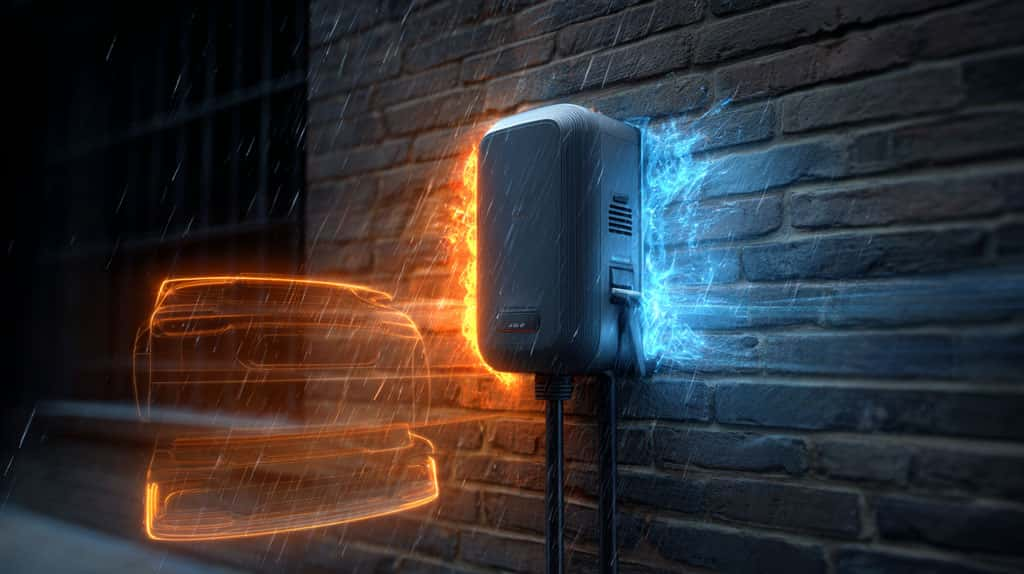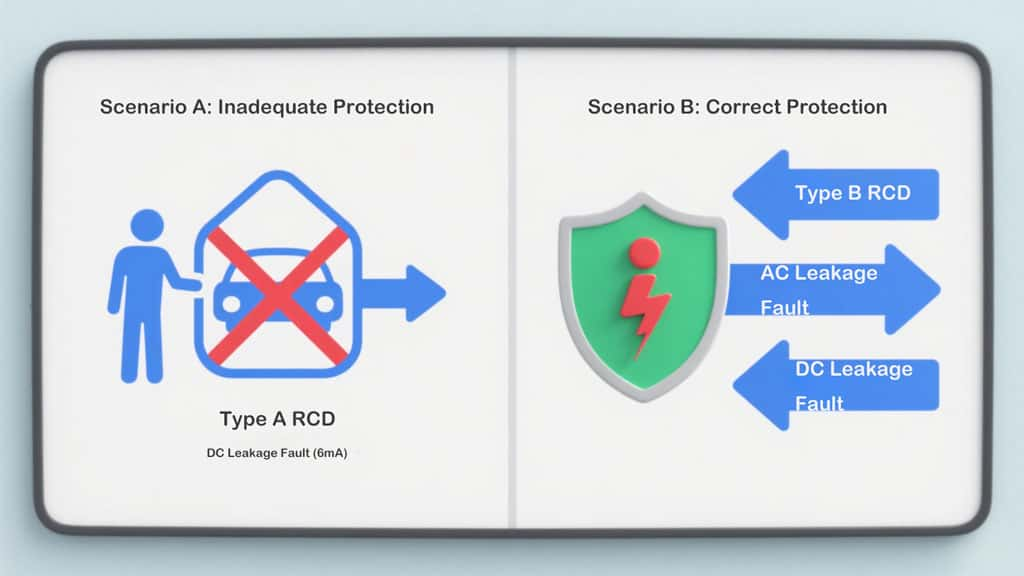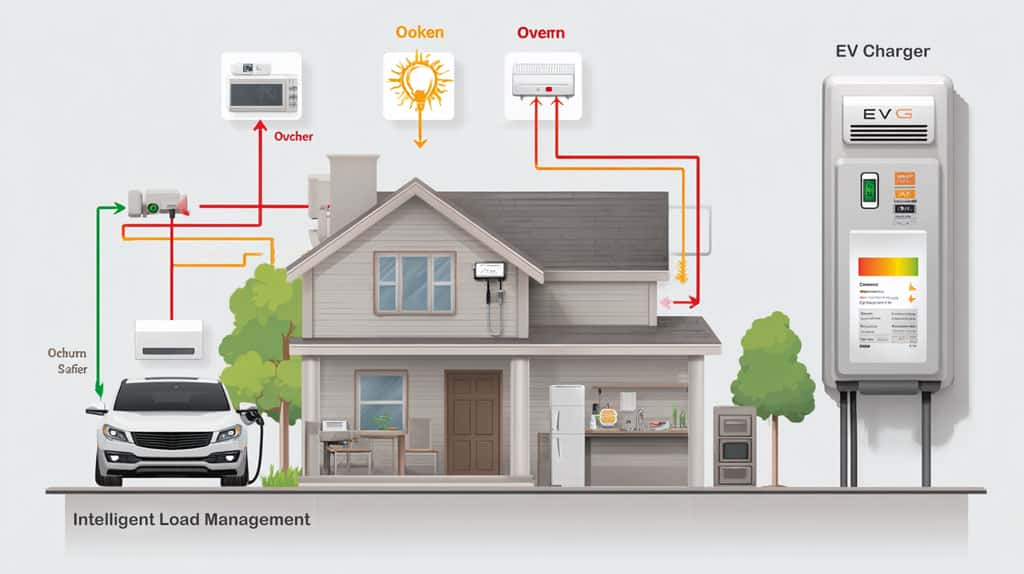You’ve made the smart move to an electric vehicle, but now a new set of worries has plugged in. Is your expensive new car truly safe while charging overnight? Could a hidden electrical fault damage its battery? What stops a simple power surge from turning your high-tech charger into a brick? These concerns are valid.
The world of EV charger safety is a minefield of technical jargon. To provide clarity, we have distilled everything you need to know into one definitive list. These are the 10 critical protection methods that separate a safe, reliable charging experience from a risky gamble.
Table Of Contents
1. Water & Dust Defense (IP Rating)

The first EV charger protection method is its physical shield against the environment. The IP Rating (Ingress Protection) is a universal standard that rates how well a device is sealed against solids (dust, dirt) and liquids (rain, snow).
Why It's Critical: Water and high-voltage electronics are a disastrous mix. An inadequately sealed charger can short-circuit during a rainstorm, causing permanent damage and creating a serious fire or shock hazard. Dust and debris can also accumulate inside, clogging cooling components and leading to overheating. For any charger, especially one installed outdoors, a high IP rating is non-negotiable.
Technical Note: The IP standard defines 'Ingress Protection,' not absolute 'waterproofing.' Following IEC 66258 international standards guidance, we recommend a minimum IP55 for outdoor chargers, with IP66 or IP67 being the ideal rating. IP66 specifically certifies protection against powerful water jets, making it the most suitable rating for long-term exposure to the elements.
What to Look For:
•The First Digit (Solids): Ranges from 0-6. You need a rating of at least 5 (Dust Protected) or 6 (Dust Tight).
•The Second Digit (Liquids): Ranges from 0-8. For an indoor garage, 4 (Splashing Water) is acceptable. For any outdoor installation, look for a minimum of 5 (Water Jets), with 6 (Powerful Water Jets) or 7 (Temporary Immersion) being even better for harsh climates. A truly waterproof EV charger will have a rating of IP65 or higher.
| IP Rating | Protection Level | Ideal Use Case |
| IP54 | Dust Protected, Splash Resistant | Indoor garage, well-covered carport |
| IP65 | Dust Tight, Protects from Water Jets | Outdoors, exposed directly to rain |
| IP67 | Dust Tight, Protects from Immersion | Outdoors in areas prone to puddles or flooding |
Elinkpower Waterproof Test
2. Impact & Collision Resistance (IK Rating & Barriers)
Your charger is often installed in a high-traffic area: your garage. It's vulnerable to bumps, scrapes, and accidental impacts from your vehicle, lawnmower, or other equipment.
Why It's Critical: A cracked or broken charger housing exposes the live electrical components within, creating an immediate and severe shock risk. Even a minor impact can damage internal connections, leading to intermittent faults or a complete failure of the unit.
What to Look For:
•IK Rating: This is a measure of impact resistance, from IK00 (no protection) to IK10 (highest protection). For a residential charger, look for a rating of at least IK08, which can withstand a 5-joule impact. For public or commercial chargers, IK10 is the standard.
•Physical Barriers: The best protection is to prevent the impact from ever happening. A proper EV Charging Station Design for a vulnerable location should include installing a steel bollard or a simple rubber wheel stop on the floor to keep vehicles at a safe distance.
3. Advanced Ground Fault Protection (Type B RCD/GFCI)

This is arguably the most important internal safety device and a cornerstone of electric vehicle charging protection. A ground fault happens when electricity leaks and finds an unintended path to the ground—which could be a person. This device detects that leakage and cuts the power in milliseconds.
Why It's Critical: A standard ground fault detector (Type A) found in many homes is blind to the "smooth DC" leakage that can be produced by an EV's power electronics. If a DC fault occurs, a Type A RCD will not trip, leaving a live fault that could be lethal. This is the single biggest hidden danger in improperly specified chargers.
What to Look For:
The charger's specifications must state that it includes protection against DC ground faults. You should look for the phrase:
"6mA DC Leakage Detection." This is mandated by the IEC 62955 international standard. In the North American market, EVSE must have this 6mA DC detection (integrated or external). In the European market, you will encounter:
Type B RCD (which detects AC, pulsating, and smooth DC faults) or RDC-DD (Residual Direct Current Detecting Device).
Notably, the RDC-DD is an efficient and widely adopted alternative to the Type B RCD specifically for Level 2 chargers, as it focuses only on detecting the distinct DC faults produced by EVs, and is certified by standards like IEC 62955.
4. Overcurrent & Short Circuit Protection
This fundamental safety feature acts like a vigilant traffic cop for electricity, protecting your home's wiring and the charger itself from drawing too much current. It prevents two main dangers.
Why It's Critical:
Every Level 2 charger feeds Alternating Current (AC) power to the car’s On-Board Charger (OBC), which is responsible for converting it into the Direct Current (DC) required by the battery. Thus, to protect the home's distribution system, the charger must be supported by a dedicated circuit from your main electrical panel. This requirement is strictly mandated by National Electrical Code (NEC) Section 625.40, which requires EVSE to be installed on a dedicated branch circuit, with wiring and breakers rated for continuous load.
What to Look For:
•Every charger has this built-in, but it must be supported by a dedicated circuit from your main electrical panel.
•The circuit breaker in your panel must be correctly sized to the charger's amperage and the wire gauge used, in full compliance with all NEC requirements for EV chargers. This is a key reason professional installation is a must.
5. Over and Under Voltage Protection
The power grid is not perfectly stable. Voltage levels can fluctuate, sagging during high demand or spiking unexpectedly. Your EV's battery and charging systems are sensitive and designed to work within a specific voltage range.
Why It's Critical:
•Over Voltage: Sustained high voltage can permanently damage your car's onboard charger and battery management system, leading to incredibly expensive repairs.
•Under Voltage (Sags): While less damaging, low voltage can cause charging to repeatedly fail, put stress on the charger's components, and prevent your vehicle from charging properly.
What to Look For:
•This is an internal feature of any quality Electric Vehicle Supply Equipment (EVSE). The product specifications should list "Over/Under Voltage Protection." The charger will automatically monitor the incoming line voltage and will pause or stop a charging session if the voltage moves outside a safe operating window.
6. Power Grid Surge Protection (SPD)
A power surge is different from over-voltage. It is a massive, instantaneous spike in voltage, usually lasting only microseconds, often caused by a nearby lightning strike or major grid operations.
Why It's Critical: A powerful surge can be an instant death sentence for any electronic device. It can flash across standard circuit breakers and fry the sensitive microprocessors in your charger and, in a worst-case scenario, your vehicle itself. Basic overcurrent protection does nothing to stop it.
What to Look For:
•Internal SPD: Some premium chargers have a basic surge protector built-in. This is good, but it's only one layer of defense.
•Whole-Home SPD (Type 1 or Type 2): The best solution is to have an electrician install a surge protection EV charger device directly at your main electrical panel or meter. This protects your charger and every other electronic device in your home from external surges. It is a relatively low-cost upgrade with a very high value.
7. Safe and Secure Cable Management
A heavy, high-voltage charging cable left on the ground is an accident waiting to happen. It's a trip hazard, and the cable itself is vulnerable to damage.
Why It's Critical: A cable that is repeatedly driven over by a car can have its internal conductors and insulation crushed, creating hidden damage that can lead to overheating or a short circuit. A dangling connector can be damaged if dropped or fill with debris, leading to a poor connection. Effective EV Charging Station Maintenance starts with proper cable handling.
What to Look For:
•Integrated Storage: A well-designed charger will include a built-in holster for the connector and a hook or wrap for the cable. This keeps everything tidy and off the ground.
•Retractors/Booms: For the ultimate in safety and convenience, especially in busy garages, consider a wall-mounted or ceiling-mounted cable retractor. It keeps the cable completely clear of the floor when not in use.
8. Intelligent Load Management

A smart EV charger protection method uses software to prevent you from overloading your home's entire electrical system.
Why It's Critical: A powerful Level 2 charger can use as much electricity as your entire kitchen. If you start charging your car while your air conditioner, electric dryer, and oven are running, you can easily exceed the total capacity of your main electrical panel, causing a whole-house blackout. EV charging load management prevents this.
What to Look For:
•Look for chargers advertised with "Load Balancing," "Load Management," or "Smart Charging."
•These units use a current sensor (a small clamp) placed on your home's main electrical feeders. The charger knows how much total power your house is using and will automatically reduce its charging speed if you approach the limit, then ramp back up when the demand drops. This feature can save you from a multi-thousand-dollar electrical panel upgrade and is a critical consideration in the total EV Charging Station Cost.
9. Professional Installation & Code Compliance
This is not a feature of the charger itself, but a procedural protection method that is absolutely critical. An EV charger is a high-power appliance that must be installed correctly to be safe.
Why It's Critical: An amateur installation can lead to countless dangers: improperly sized wires that overheat, loose connections that create electrical arcs (a major fire cause), incorrect breaker types, and non-compliance with local electrical codes, which can void your homeowner's insurance. The EV charger safety is only as good as its installation.
What to Look For:
•Always hire a licensed and insured electrician. Ask if they have experience installing EV chargers.
•They will ensure a dedicated circuit is used, the wire gauge is correct for the amperage and distance, all connections are torqued to specification, and all work meets local and National Electrical Code (NEC) standards. The money spent on a professional is a critical part of the EV Charger Cost and Installation.
10. Verified Third-Party Safety Certification (UL, ETL, etc.)
A manufacturer can make any claim it wants on its website. A certification mark from a trusted, independent testing laboratory means the product has been rigorously tested to established safety standards.
Why It's Critical: Uncertified chargers, often found on online marketplaces, have not been vetted by an independent third party. They may lack the critical internal protections listed above, use substandard components, or have dangerously flawed designs. A certification mark is your proof that the charger has been tested for electrical safety, fire risk, and durability.
What to Look For:
•Look for a genuine certification mark on the product itself and its packaging. The most common marks in North America are:
UL or UL Listed: Does your charger comply with UL 2594 (Standard for Electric Vehicle Supply Equipment) and UL 2231 (Standard for Personnel Protection Systems)? These certifications involve continuous, full-load operational tests to ensure the product won't overheat or cause a fire under strenuous conditions.
ETL or ETL Listed: From Intertek.
CSA: From the Canadian Standards Association.
•These certifications are the foundation of EVSE protection. Never purchase or install a charger that does not carry one of these marks. Advanced systems enabling features like V2G or managed by a Charge Point Operator will always have these core certifications.
By ensuring all ten of these critical protection methods are in place, you are building a comprehensive system of safety that protects your investment, your home, and your family. You can charge with total confidence, knowing you've made the smart, safe choice.
At elinkpower, we are committed to an industry-leading standard of excellence for every EV charger we produce.
Our core differentiator lies in "Proactive Defense and Cost Efficiency." For instance, our IK10 impact resistance and IP66/67 protection design (validated by internal 48-hour continuous high-pressure spray tests) ensure unparalleled physical durability. Safety-wise, beyond UL Certification, we integrate Arc Fault Circuit Interrupter (AFCI) detection—a function more advanced than traditional overcurrent protection that can identify and shut down electrical fire hazards 90% sooner. This comprehensive safety approach, according to our internal studies, saves users an average of 18% on long-term maintenance and potential upgrade costs.
This comprehensive approach to safety isn't just a promise—it's certified. Our products are validated by the world's most trusted authorities, holding UL, ETL, CSA, FCC, TR25, TUV and ENERGY STAR certifications. When you choose elinkpower, you aren't just buying a charger; you are investing in expertly engineered durability, certified safety, and ultimate peace of mind for the road ahead.
Post time: Jul-10-2025


